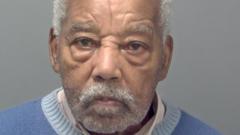What Led to the Capture of a Cold Case Killer After 50 Years?

Uncovering the Shadows of Time: The Conviction of Ryland Headley
The recent conviction of Ryland Headley for the murder and rape of Louisa Dunne, a 75-year-old woman killed in 1967, has sent shockwaves through the community and reignited discussions about cold cases and the persistence of justice. After nearly six decades of unanswered questions and a trail that had long gone cold, the combination of old evidence and modern forensic techniques led to a groundbreaking breakthrough. This case not only highlights the capabilities of contemporary policing but also underscores the enduring impact of crime on victims' families and communities.
The Shocking Crime of 1967
On June 28, 1967, Louisa Dunne was found dead in her home on Britannia Road, Easton, Bristol. A beloved figure in her neighborhood, Mrs. Dunne was known for her friendly demeanor and often spent her days chatting with neighbors or observing daily life from her doorstep. However, on that fateful morning, her absence was noted when she failed to collect her daily newspaper. Concerned neighbors entered her home to find her lifeless body, a scene that would haunt the community for generations.
The initial investigation revealed that Mrs. Dunne had been brutally attacked. She was found with her clothing intact but her underwear around her ankles, indicating a violent struggle. Bruises on her neck suggested she had been strangled with her own scarf, and there were signs that something heavy had been placed over her mouth to stifle her cries. A DNA swab later tested positive for semen, but forensic evidence at the time was scarce, and police were left with a single palm print found on a window frame.
The Hunt for Justice
In the wake of Mrs. Dunne's murder, police launched one of the largest manhunts in Bristol's history. Investigators took palm prints from over 19,000 men in a 1.5-mile radius of the crime scene, including those convicted of sexual offenses and even homeless individuals. Despite the extensive efforts, the investigation led nowhere, and Headley, who lived just outside the police's search area, remained undetected.
Fast forward ten years, and another series of violent crimes brought Headley back into the spotlight. In the late 1970s, he was arrested for the rapes of two elderly women in Ipswich. His pattern of targeting vulnerable women suggested a disturbing familiarity with local neighborhoods. Despite pleading guilty to the rapes, the connection to Mrs. Dunne's murder was never made due to the lack of a national database that could have linked him to the earlier crime.
The Resurgence of Hope
After decades of silence, the case was reopened in 2023 by a dedicated team at Avon and Somerset Police. Detective Joanne Smith and her colleagues poured over boxes of evidence from the original investigation, determined to find any lead that could bring justice to Mrs. Dunne and her family. To their amazement, they discovered that key pieces of evidence, including Mrs. Dunne's clothing and crime scene photographs, had been meticulously preserved.
Forensic scientist Andrew Parry from Cellmark Forensic Services played a pivotal role in the investigation, employing modern DNA analysis techniques to establish a definitive link between Headley and the crime. A square of cloth cut from the back of Mrs. Dunne's skirt yielded a full DNA profile, and the results were overwhelmingly incriminating. Parry testified in court that the likelihood of the sperm cells belonging to anyone other than Headley was "a billion times" more probable. This revelation marked a turning point in the case, breathing new life into a decades-old investigation.
The Arrest of Ryland Headley
When Ryland Headley was arrested, the police team had no trouble obtaining his palm print, a crucial piece of evidence that had eluded them for years. His previous refusal to provide a palm print under the pretense of arthritis raised questions about his awareness of the investigation. Detective Smith expressed her satisfaction that the long-dormant case had finally led to a breakthrough, stating, "It’s satisfying to know what started off as a dusty old box in our archive store has ended up with justice being served." Despite being a frail 92-year-old, Headley was charged, and the case proceeded to trial.
The Trial and Its Implications
The trial at Bristol Crown Court was a significant moment in the pursuit of justice for Mrs. Dunne. The jury's guilty verdict not only marked a closure for the victim's family but also set a precedent for cold cases. It demonstrated that time does not diminish the pursuit of justice and that law enforcement agencies remain committed to bringing offenders to account, regardless of how many years may have passed.
As the jury deliberated, the weight of the evidence—decades-old forensic samples juxtaposed with modern DNA analysis—underscored the importance of technological advancements in solving crimes that had once seemed impossible to resolve. The success of the investigation revitalized public interest in cold cases, highlighting the need for continued investment in forensic science and investigative techniques.
The Psychological Impact on Victims' Families
The long wait for justice can take a profound toll on victims' families and communities. For the Dunne family, the years of uncertainty were marked by pain and frustration. The conviction of Headley provides a sense of closure, but it also raises questions about the nature of justice and the long-lasting effects of violent crime. Communities affected by such tragedies often bear the burden of grief and fear for years after the event, making each breakthrough in long-standing cases a reminder of the dangers that persist.
In cases like Mrs. Dunne's, the psychological impact extends beyond the immediate family to the broader community. Neighbors and friends who once felt safe may grapple with feelings of vulnerability and mistrust. The reopening of such cases can provoke deep-seated emotions, prompting individuals to confront their own experiences with crime and loss.
The Future of Cold Case Investigations
The successful conviction of Ryland Headley serves as a critical reminder of the importance of revisiting cold cases with fresh eyes and modern techniques. As forensic science continues to evolve, law enforcement agencies can harness new technologies to solve crimes that have long eluded justice. Here are some steps that can be taken to improve cold case investigations:
- Investment in Forensic Technology: Continued funding for forensic laboratories and training in new techniques will help law enforcement agencies analyze old evidence more effectively.
- Creation of National Databases: A centralized database that includes DNA and fingerprint records from unsolved cases could improve the chances of linking suspects to multiple crimes.
- Community Involvement: Engaging with the community to gather new leads and encouraging witnesses to come forward can provide valuable insights that may have been overlooked in past investigations.
- Cross-Agency Collaboration: Sharing information and resources among different law enforcement agencies can lead to a more comprehensive approach to solving cold cases.
Conclusion: The Pursuit of Justice
The conviction of Ryland Headley for the murder of Louisa Dunne is an example of how perseverance in law enforcement can yield results, no matter how much time has passed. The commitment to seek justice for victims, combined with advancements in forensic technology, can help bring closure to families and communities affected by violent crime. It serves as a powerful reminder that the quest for justice is never truly over, and those who commit heinous acts cannot escape the long arm of the law forever.
As we reflect on this case, we are reminded of the resilience of the human spirit and the importance of continuing the fight for justice. The story of Louisa Dunne and Ryland Headley is one of sorrow but also one of hope—a testament to the dedication of those who refuse to let the past fade into obscurity.
FAQs about Cold Cases and Justice
What is a cold case?
A cold case is a criminal investigation that has not been solved or leads have gone cold, often due to a lack of evidence or viable suspects. Cold cases can be reopened if new evidence or technology becomes available.
How are cold cases typically investigated?
Cold cases are often revisited by specialized teams who review old evidence, witness statements, and forensic findings. New forensic technology, such as DNA analysis, can provide new leads and insights into unsolved cases.
What role does DNA evidence play in solving cold cases?
DNA evidence is crucial in cold cases, as it can link a suspect to a crime scene, even if years have passed since the crime occurred. Advances in forensic science have made it possible to extract and analyze DNA from older evidence, leading to new breakthroughs in investigations.
As we conclude this discussion on the intersection of time, justice, and forensic science, we are left to ponder: how many more untold stories lie hidden in the archives, waiting for the right combination of technology and determination to bring them to light? #ColdCaseJustice #ForensicScience #UnsolvedMysteries
Published: 2025-06-30 19:58:16 | Category: technology



